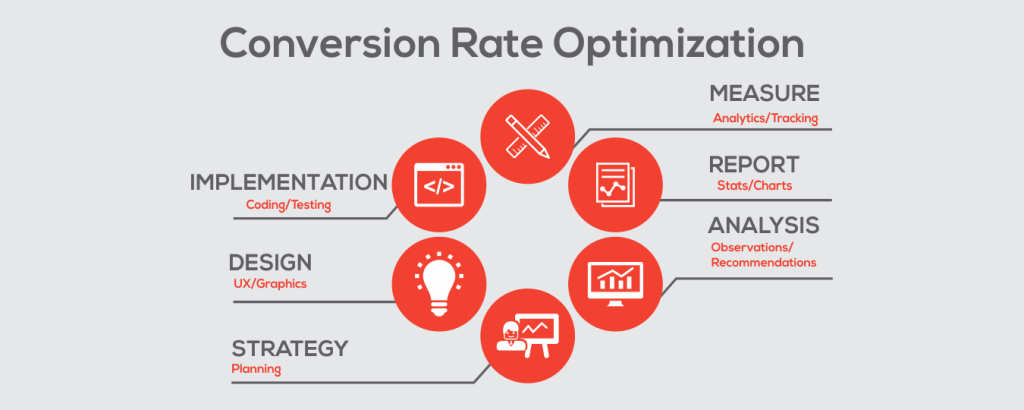As a website owner or marketer, you work hard to drive traffic to your site. You invest in SEO, create compelling content, and run effective advertising campaigns. But what happens when all that traffic arrives at your site? Are you converting those visitors into leads or customers? If not, it’s time to think about conversion rate optimization (CRO) either independently or by seeking help from the best e-commerce SEO services.
CRO is the process of improving the percentage of visitors to your site who take a desired action, such as filling out a form, making a purchase, or subscribing to your newsletter. However, there are common mistakes that many businesses make when it comes to CRO. In this blog post, we’ll discuss 11 of the most common CRO mistakes and how to avoid them.
Importance of Avoiding CRO Mistakes
Avoiding CRO mistakes is crucial for the success of your business. When you make mistakes with your CRO strategy, you may end up spending a lot of time, effort, and money on strategies that don’t work. In the end, this can lead to a lower conversion rate and a lower return on investment (ROI).
On the other hand, when you avoid CRO mistakes, you can increase the chances of success for your strategies. You’ll be able to focus on what works and make the most of your efforts. This will help you achieve a higher conversion rate and a better ROI.
Avoid These Conversion Rate Optimization Mistakes in 2023
Mistake #1: Not Defining Goals Clearly
One of the biggest mistakes you can make in CRO is not having clear goals. Without clear goals, it’s difficult to know what changes to make on your website and whether or not those changes are effective. For example, if your goal is to increase sales, you need to know which pages on your website are most important for driving those sales and what specific changes you can make to those pages to improve conversions.
To avoid this mistake, take the time to define your goals clearly. Identify the key actions that you want visitors to take on your website and prioritize them based on their importance to your business. Then, develop a plan for testing and optimizing those pages to improve conversions.
Mistake #2: Not Understanding the Target Audience
Another common mistake in CRO is not understanding your target audience. If you don’t know who your visitors are and what they’re looking for, it’s difficult to create a website that meets their needs and encourages them to take action. For example, if your target audience is primarily millennials, you may want to prioritize social proof and user-generated content on your website, while if your audience is primarily baby boomers, you may want to focus more on trust indicators like customer reviews and testimonials.
To avoid this mistake, take the time to research and understand your target audience. Use tools like Google Analytics to gather data on their demographics, behavior, and interests. Then, use this information to create a website that speaks directly to their needs and motivations.
Mistake #3: Having a Slow Website
Website speed is a crucial factor in CRO. If your website is slow to load, visitors are likely to leave before they even have a chance to convert. In fact, a study by Google found that as page load time goes from 1 second to 5 seconds, the probability of bounce increases by 90%.
To avoid this mistake, invest in tools and resources to speed up your website. This might include optimizing images, minifying code, and using content delivery networks (CDNs) to reduce server response time.
Mistake #4: Not Optimizing for Mobile
In today’s mobile-first world, not optimizing your website for mobile is a huge mistake. With more than half of all website traffic coming from mobile devices, it’s crucial that your website is responsive and easy to use on all types of devices.
To avoid this mistake, make sure your website is optimized for mobile by using a responsive design that adapts to different screen sizes. Test your website on a variety of devices to ensure that it’s easy to use and navigate on all platforms.
Mistake #5: Ignoring the Importance of UX
User experience (UX) is a critical factor in CRO. If your website is difficult to navigate or doesn’t provide a positive experience for visitors, it can negatively impact your conversion rates. Some examples of bad UX include slow loading times, confusing navigation menus, and poor mobile optimization.
To improve UX and, in turn, CRO, it’s important to prioritize user testing and feedback. Conduct surveys, usability tests, and heat mapping to understand how visitors interact with your website and identify areas for improvement. Additionally, consider implementing responsive design to improve the mobile experience and ensure that all content is easy to access and navigate.
Mistake #6: Not Testing Enough
Testing is a crucial component of CRO. A lack of testing can lead to missed opportunities for improvement and ultimately hinder your conversion rates. Some examples of not testing enough include failing to A/B test different variations of landing pages or neglecting to test new marketing campaigns before launching them.
To test more effectively, start by identifying key performance indicators (KPIs) for your website and setting up analytics tracking to measure them. Conduct A/B tests on different elements of your website, such as headlines, images, and calls to action, to determine what resonates best with your audience. Additionally, continuously monitor and analyze your results to identify further opportunities for improvement.
Mistake #7: Not Using Data to Make Decisions
Data-driven decision-making is essential for CRO success. Without data, it’s difficult to identify areas for improvement or determine what strategies are working and what aren’t. Some examples of not using data include making changes to your website based on guesswork rather than analytics or failing to track and analyze user behavior.
To use data effectively, start by setting up analytics tracking to measure KPIs and track user behavior. Use this data to identify areas for improvement and develop hypotheses for testing. Additionally, consider implementing tools such as heat mapping and user recording to gain further insight into user behavior and identify pain points on your website.
Mistake #8: Having Complicated Forms
Complicated forms can be a major barrier to conversion. Visitors may become frustrated or overwhelmed when asked to fill out too many fields or provide too much information. Some examples of complicated forms include requiring multiple steps to complete a form or asking for unnecessary information.
To simplify forms and improve CRO, consider minimizing the number of fields required to complete a form. Use clear and concise language to explain what information is needed and why. Additionally, consider implementing autofill features to make it easier for visitors to complete forms quickly and efficiently.
Mistake #9: Not Optimizing for Search Engines
Search engine optimization (SEO) is an important component of CRO. If your website isn’t optimized for search engines, it may not appear in relevant search results, preventing potential visitors from finding your site. Some examples of not optimizing for search engines include failing to incorporate relevant keywords into your content or neglecting to add meta descriptions and titles to your pages.
To optimize your website for search engines and improve CRO, start by conducting keyword research to identify relevant keywords for your business. Incorporate these keywords strategically into your content and meta descriptions. Additionally, ensure that your website is mobile-friendly and has a fast loading time, as these factors can impact your search rankings.
Conclusion
In conclusion, e-commerce conversion rate optimization is a crucial aspect of online marketing and can significantly impact the success of your business. However, it’s important to avoid common mistakes such as not understanding your audience, neglecting mobile optimization, and ignoring the importance of testing and tracking. By avoiding these mistakes and taking a strategic approach to conversion rate optimization, you can improve your website’s performance and ultimately achieve your business goals. Remember to focus on providing a seamless user experience, offering value to your visitors, and continuously testing and refining your strategies to see the best results.








